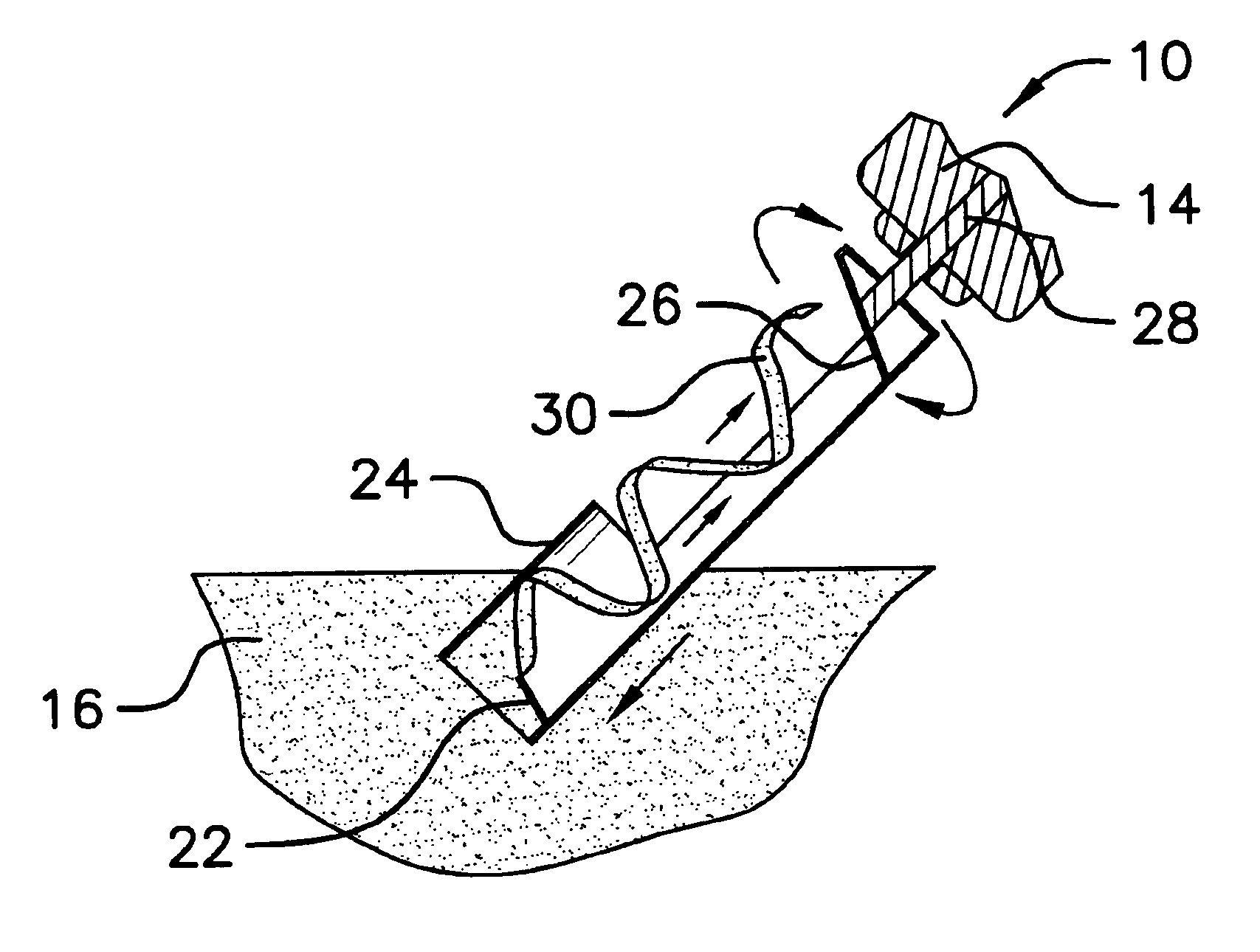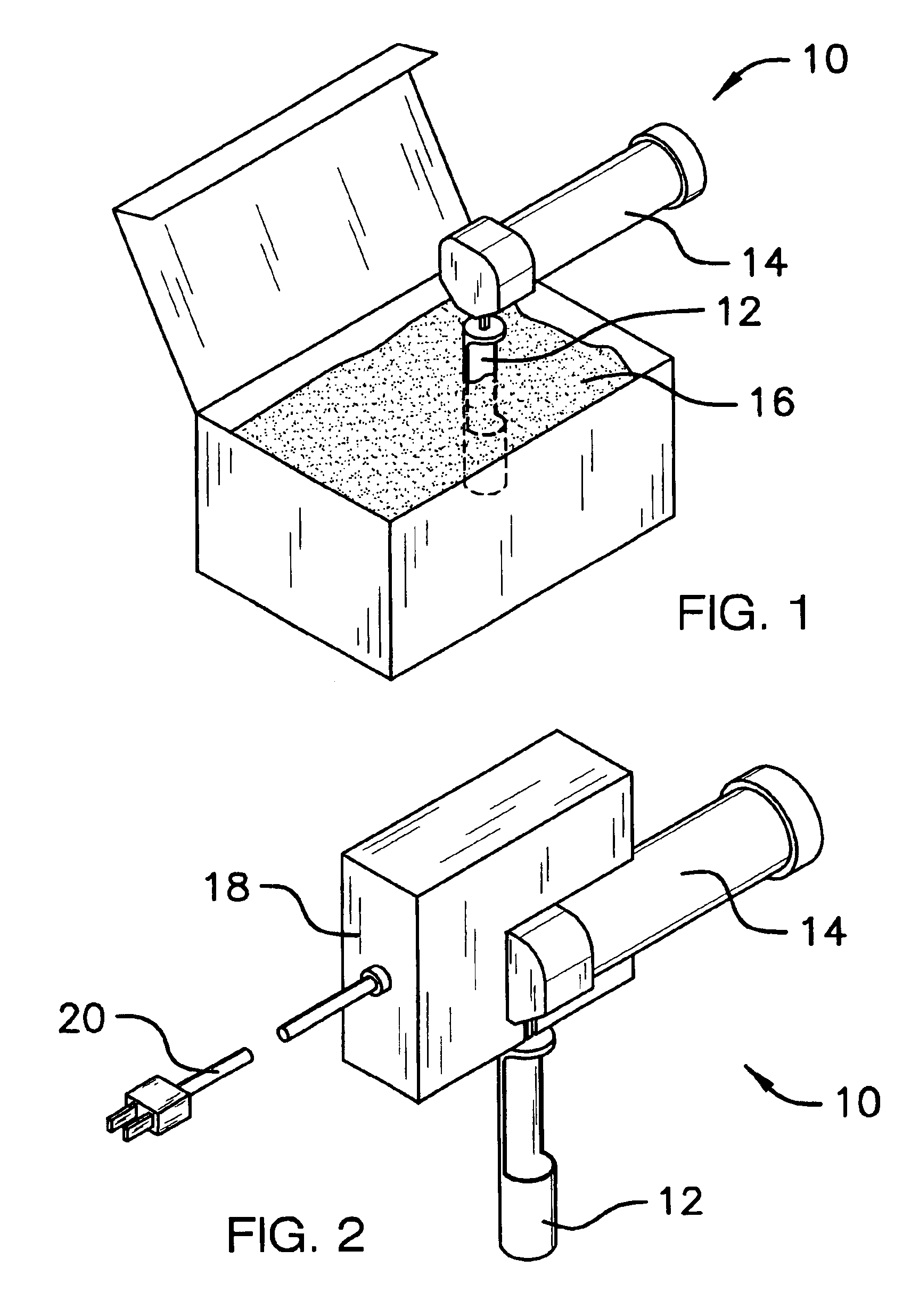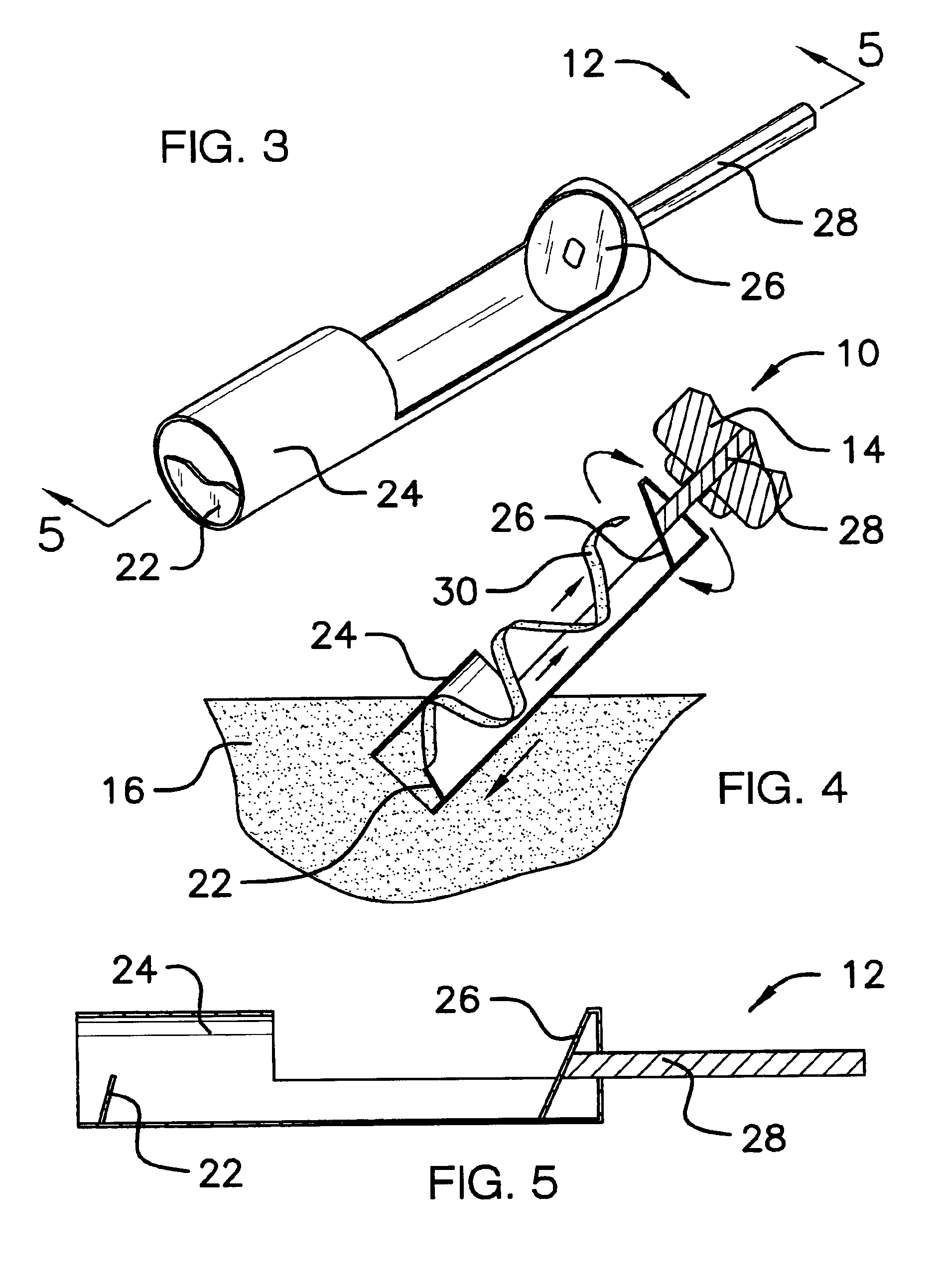One of the most prevalent problems with serving ice cream is that it is often very hard when it has been in the freezer for any length of time, making it difficult to insert the scooping device into the container.
In addition, individuals with limited hand,
wrist, and / or arm strength find it difficult to scoop ice cream in this manner.
Other problems include ice cream sticking in the scoop due to its hemispherical shape.
Many types of wiping blades have been invented to alleviate this problem, but these are largely ineffective since the ice cream tends to freeze to the internal side of the scoop.
Plungers have also been implemented to help eject the scooped ice cream, but the cups used in these implementations have difficulties with presenting aesthetically pleasing servings and with holding softer ice cream.
However, the placement of the
handle of the Moonan '976 device with respect to the scoop would make it difficult to scoop ice cream while grasping the
handle.
Further, the shaft of the scoop cannot be grasped during the scooping process since the rod that supports the
plunger is not covered.
However, if the ice cream to be dispensed by the Ralls '843
server were somewhat melted, the portion of the substance in the bowl would tend to fall out as the
server was drawn upward from the ice cream container.
Additionally, the
cutting edge of the bowl could
pose a safety
hazard upon which the user or other individuals might
cut themselves.
Lastly, the wiper blade of the Ralls '843 device is not an overly effective means for releasing ice cream from the bowl and could require intervention from the user to accomplish the release.
'555 patent fails to provide a
cutting edge on the cup; therefore the user would need to exert sufficient hand,
wrist, and arm strength to pass the scoop through hard, frozen ice cream.
This could be a difficult proposition for young children, the elderly, or for any individual with limited strength or physical ailments in the hands or arms.
In addition, the position of the cup with respect to the
handle would make it difficult to scoop ice cream from conventional containers.
'555 device would not be capable of retaining slightly melted ice cream while it is drawn from a container.
However, the ice cream which is not completely frozen would tend to fall out of the Harris '943 device when it is lifted from the container.
Furthermore, the shape of the cylindrical cup does not lend itself to conventional serving portions of ice cream.
Lastly, the
cutting edge of the Harris '943 device could present a safety
hazard for the user or a child who accidentally picks up the
dipper.
'852 patent fails to provide a mechanism for helping remove the ice cream from the spoon portion of the scoop.
Additionally, heating the scoop would tend to make the ice cream melt, which might not be acceptable to those consuming the ice cream.
'852 scoop would need to possess sufficient hand,
wrist, and arm strength to pass the scoop through hard, frozen ice cream, which could be difficult for those with limited strength or physical ailments in the hands or arms.
'591 patent fails to provide a mechanism by which ice cream, or a similar material, could be scooped from a container; therefore, it would not be feasible for use in this capacity.
Furthermore, the hemispherical spoon tends to retain the ice cream and does not permit its easy release.
Lastly, the sweeping band, which is intended to remove the ice cream by sweeping the inner surface of the spoon, is ineffective in releasing the ice cream easily.
Additionally, heating the
dipper would cause the ice cream to begin melting, which might not be agreeable to those eating the ice cream.
Finally, the sharp, serrated edges of the
dipper could
pose a danger to the user or a small child who might pick up the scoop.
However, the Cartellone '944 patent fails to provide a mechanism by which ice cream, or a similar material, could be scooped from a container; therefore, it would not be feasible for use in this capacity.
However, the Caswell '744 patent fails to provide an enclosed tube around the blades and into which ice cream, or another substance, could be contained after being
cut.
In addition, the Caswell '744 device is not electrically powered and would require a significant amount of arm and
hand strength to operate.
Finally, the Caswell '744 device would present a danger to users since neither the boring nor the spiral blades are shielded in any manner.
However, users having limited wrist and arm strength, such as the elderly, persons suffering from
arthritis, or young children, would find it difficult to scoop hard ice cream with the Wong '784 device since it fails to provide electrical aid or an ice cream
softening agent.
Furthermore, the bowl of the Wong '784 device would tend to retain the ice cream and would cause difficulty when the user attempted to release the ice cream.
'551 patent tends to retain the ice cream and does not permit its easy release.
In addition, the movable bail, which is intended to remove the ice cream by sweeping the inner surface of the scoop, is ineffective in releasing the ice cream easily.
Finally, the scoop would be difficult to clean, especially due to the placement of the cutter and moveable bail.
However, the cup member of the Darnell '516 patent would be difficult to clean, especially under the
plunger and around the teeth of the cutting edge.
In addition, if the ice cream, or other substance to be dispensed, were somewhat melted, the portion of the substance in the cup would tend to fall out as the dispensing device was drawn upward from the container which houses the substance.
While the above-described devices fulfill their respective, particular objectives and requirements, the aforementioned patents do not describe an auger scoop that allows the user to easily scoop decorative servings of frozen ice cream.
None of the aforementioned patents provide a device which can serve ice cream in a decorative manner.
'591 and the Cartellone '944 patents fail to provide a mechanism by which ice cream, or a similar material, could be scooped from a container; therefore, they would not be feasible for use in this capacity.
Furthermore, the Caswell '744 patent fails to provide an enclosed tube around the blades and into which ice cream, or another substance, could be contained after being
cut.
This could be difficult for the young or elderly, as well as those suffering from arthritis or other
physical limitations.
'163, and Caswell '744 devices could
pose a safety
hazard wherein the user or other individuals might cut themselves.
'555, and Harris '943 devices would make it difficult to scoop ice cream from conventional containers, and the shape of the cylindrical cup of the Harris '943 device does not lend itself to conventional serving portions of ice cream.
'551 devices tend to retain the ice cream and do not permit its easy release.
'551 and Ralls '843 devices, which is intended to remove the ice cream by sweeping the inner surface of the spoon, is ineffective in releasing the ice cream easily.
'852 patent fails to provide a mechanism for helping remove the ice cream from the spoon portion of the scoop.
'163 patents make provisions for heating the devices; however, this could make the ice cream melt, which might not be acceptable to all consumers.
'551 and Darnell '516 devices would be difficult to clean, and the Denison, et al.
 Login to View More
Login to View More 


